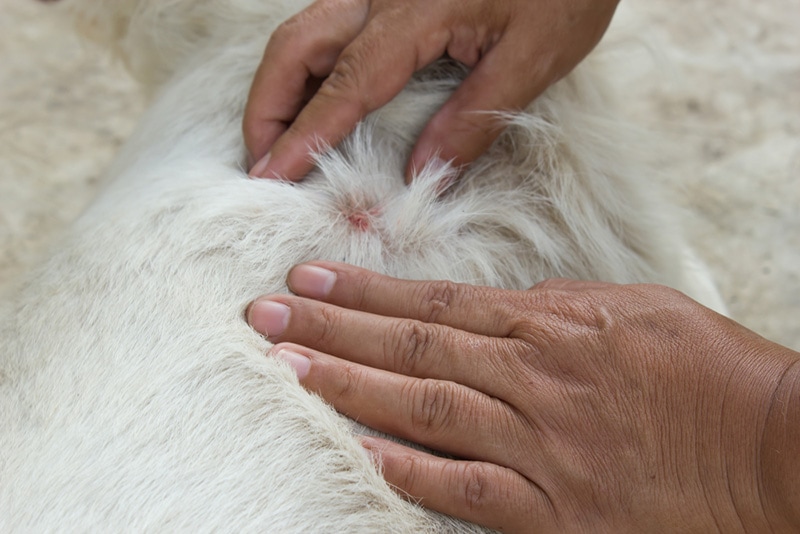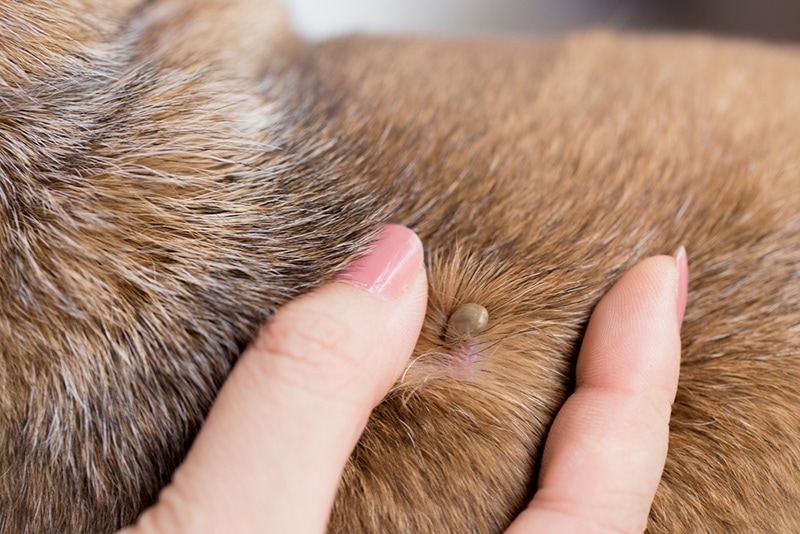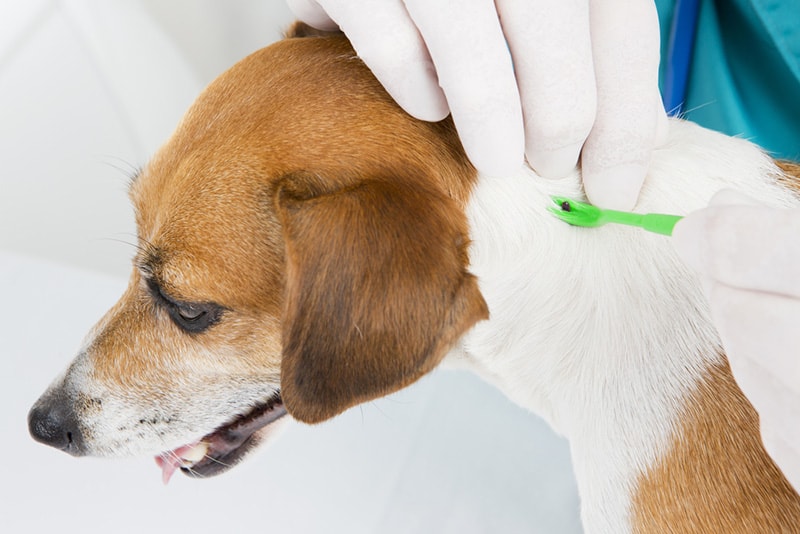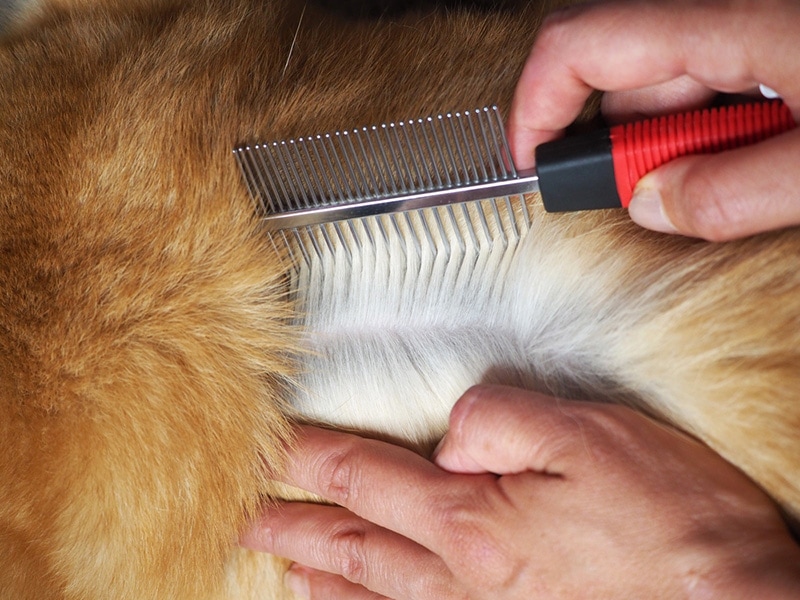Dog Bit by a Tick? Here’s What to Do (Our Vet Answers)
Updated on

Click to Skip Ahead
If the worst should happen, here is everything you need to know about what to do and what to watch out for.
What Are Ticks?
What do spiders, mites, scorpions, and ticks have in common? They’re all part of the arachnid family, which are neither bugs nor insects. Ticks are a skin parasite of animals, including humans. They have eight legs, a gnarly mouthpiece, protective scutum, and an expandable body, necessary for when they engorge themselves on blood.
Ticks are usually too small to feel crawling on the skin, and their bite also often goes unnoticed. The problem with ticks is that they can make a dog or other animal sick, either by taking too much blood or by infecting the animals with diseases.
Ticks have several life stages, which can vary by species. The immature life stages are almost too small to see, and the adults are still pretty small unless they’re full of blood from feeding.

The 5 Things to Do if Your Dog Is Bit by a Tick
The most important thing to do is remove the tick, but don’t panic and rush, as you’ll want to take your time and get this right. Here are some tips to remember:
1. Watch Out for the Mouthpiece
When removing a tick, it is possible to accidentally leave the mouthpiece of the tick in the skin, as it is long, and ticks have a strong bite. Leaving the mouthpiece behind can cause local pain, inflammation, and infection, so while it isn’t the end of the world if it’s left behind, you certainly want to avoid it.
2. Use a Tick-Removing Tool
The easiest way to remove a tick successfully is to use a tick-removing tool. These are available from online pet supply retailers, are affordable, and will slip under the body of the tick and catch that body as you pull straight up, taking the mouthpiece with it.

3. Tweezers Work Too
While keeping a tick removal tool in your home for when you need it is recommended, tweezers will also work. To remove a tick with tweezers, pinch the tick firmly and as close to the skin as possible and pull it straight up. Inspect the skin for signs of the mouthpiece afterward. It should be visible against light skin tones. If the mouthpiece is still remaining, you may be able to still pull it out with the tweezers. If not, your dog’s skin will force it out in time, but you’ll need to monitor their skin for signs of infection over the next couple of weeks.
4. Clean the Tick Bite
After removing the tick, clean the tick bite site with soap and water. Without touching the tick with your bare hands, place the tick into isopropyl alcohol to kill it. If you have a small vial, you can preserve the tick in this. Otherwise, you can transfer them to a small, clear baggie.
5. Bring Your Dog for a Vet Checkup
When you have removed a tick from your dog, bring them to the vet for a checkup and bring the tick with you for identification. Some tick species can be easily identified, and others need the help of a laboratory to be sure. A veterinarian can coordinate sending a tick for identification and even to check which diseases it’s carrying because different ticks can infect a dog (or people) with different things and often more than one thing.

How Do Dogs Get Ticks?
Ticks are very good at their job. To progress to each new life stage, they must first feed, then molt. For ticks to bite dogs, they will usually crawl to the top of blades of grass, especially long grass, and wait to catch a passing animal, which they can sense through changes in temperature, carbon dioxide levels, vibrations, and more.
Most ticks will crawl up an animal until they reach a preferred area to start feeding. This behavior can vary between species, but in general, by far the most likely place you’ll find a tick on a dog is on their head. This can include around their eyes or in their ears.
Dogs walking through unmowed grass in the spring or fall are at high risk of tick bites. Yes, you read that right; spring and fall are peak tick seasons for most species, not summer.
Important Tick-Borne Illnesses in Dogs
The most famous tick-borne disease is Lyme disease, caused by the bacteria Borrelia burgdorferi. There are many others, though, such as the following:
- Ehrlichiosis
- Anaplasmosis
- Babesiosis
- Rocky Mountain Spotted Fever
- Tularemia
- Powassan virus
- Rickettsiosis
- Heartland virus
- STARI
- Colorado Tick Fever
Different ticks transmit different diseases, though they can transmit more than one, and different diseases can be transmitted by more than one tick species.
In addition to disease transmission, female ticks of some species can cause something known as tick paralysis. These female ticks have a neurotoxin in their saliva that causes rapid, ascending weakness or paralysis in dogs until the tick is removed. This usually takes about a week to start happening.
In fact, no tick-borne diseases are transmitted immediately upon biting either. While there are no guaranteed timelines, most infectious agents are very unlikely to be transmitted in the first 12 hours, often longer. This means that avoidance of tick-borne diseases relies upon early detection and removal of the tick.

Signs of Tick-Borne Illness in Dogs
Be aware of the following signs of tick-borne illnesses in dogs:
- Lethargy
- Inappetence
- Limping
- Weakness
- Paralysis
- Exercise intolerance
- Vomiting
- Weight loss
- Swellings on the neck (swollen lymph nodes)
- Poor clotting
How to Prevent Tick Bites
Tick prevention is multifaceted. To prevent tick bites, don’t allow your dog to walk through tall grass if you can. Yards can be treated with acaricides, AKA tick pesticides. Leaf piles are another place ticks love, especially in the fall, so as tempting as it may be, keeping your dog out of leaf piles is a good idea.
When your dog does participate in an activity with a significant risk of tick exposure, it is best to perform a tick check. For those that don’t live in tick endemic areas and don’t already know what that means, you’ll need to use your hands to feel all over your dog for any bumps on the skin immediately after the activity and over the next couple of days, trying to feel for feeding ticks. For dogs with short hair coats, it’s best to also try to search the skin for signs of ticks. Using a flea comb can help remove unattached fleas from a dog’s hair coat, especially if their coat is long.
Tick preventatives for dogs don’t actually prevent bites in most cases. These aim to kill the ticks before they can transmit disease, but they could still get bitten in that time.
The preventative medications are typically topical or oral, and the best and safest results will be found in prescription tick preventative medications. Maintaining preventatives is important, as this helps break the reproduction cycle, especially in your yard, and catches any ticks you didn’t.
It’s impossible to prevent all tick exposure, to find all ticks before they bite, or to kill all ticks with preventative alone, so the best thing to do is approach this problem from as many directions as you can. While most ticks need to live outside, some have adapted to living inside homes, which means even dogs that never go outside or dogs living in a cold climate or winter season are still at risk.

Frequently Asked Questions (FAQs)
Should I take my dog to the vet after a tick bite?
When your dog is bitten by a tick, you should remove the tick, kill and preserve or save the tick, and make an appointment to see your veterinarian, but not for 4 to 6 weeks unless your dog shows signs of an infection at the site of the bite. This is because the basic tick-borne disease screening tests need time after the bite before they are accurate.
How long after a tick bite do signs of illness appear?
This can be as little as 5 days for tick paralysis or years for others if the dog ever shows signs.
Can a dog survive a tick bite without treatment?
Yes, they can, and this happens all the time. If a tick is causing tick paralysis, though, an untreated dog can die from respiratory paralysis in less than a week.
Are tick-borne diseases contagious to humans?
The diseases aren’t contagious in that they don’t spread from a dog to humans, but many of the same diseases dogs can get from ticks, humans can also get, like Lyme disease.

 Conclusion
Conclusion
Ticks can be an annoyance and even cause health problems for your dog. Even if a tick is removed cleanly—mouthpiece intact—a raised, potentially itchy area of inflammation at the bite site is common and may persist for up to a week. If this is a problem for longer or grows bigger, the mouthpiece may still be inside or the bite may be infected, so it is best to have that checked by a veterinarian.
Related Read:
- Revolution vs. Frontline: Which Flea & Tick Treatment Is Better?
- Rocky Mountain Spotted Fever in Dogs: Causes, Signs and Treatments (Vet Answer)
Featured Image Credit: Seeme, Shutterstock













